College
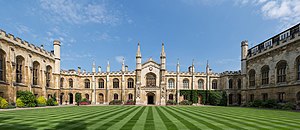

A college (Latin: collegium) is an educational institution or a constituent part of one. A college may be a degree-awarding tertiary educational institution, a part of a collegiate or federal university, an institution offering vocational education, a further education institution, or a secondary school.
In most of the world, a college may be a
Etymology

The word "college" is from the
Overview
Higher education
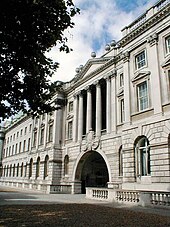
Within higher education, the term can be used to refer to:[7]
- A constituent part of a collegiate university, for example King's College, Cambridge, or of a federal university, for example King's College London.
- A liberal arts college, an independent institution of higher education focusing on undergraduate education, such as Williams College or Amherst College.
- A liberal arts division of a university whose undergraduate program does not otherwise follow a liberal arts model, such as the Yuanpei College at Peking University.
- An institute providing specialised training, such as a college of further education, for example Belfast Metropolitan College, a teacher training college, or an art college.
- A Catholic higher education institute which includes universities, colleges, and other institutions of higher education privately run by the Catholic Church, typically by religious institutes. Those tied to the Holy See are specifically called pontifical universities.
- In the United States, college is sometimes but rarely a synonym for a research university, such as Dartmouth College, one of the eight universities in the Ivy League.
- In the United States, the undergraduate college of a university which also confers graduate degrees, such as Yale College, the undergraduate college within Yale University.
Further education
A
Secondary education
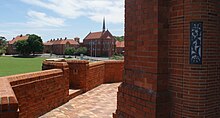
In some national education systems, secondary schools may be called "colleges" or have "college" as part of their title.
In Australia the term "college" is applied to any private or independent (non-government) primary and, especially, secondary school as distinct from a state school. Melbourne Grammar School, Cranbrook School, Sydney and The King's School, Parramatta are considered colleges.
There has also been a recent trend to rename or create government
In a number of Canadian cities, many government-run secondary schools are called "collegiates" or "
In New Zealand the word "college" normally refers to a secondary school for ages 13 to 17 and "college" appears as part of the name especially of private or integrated schools. "Colleges" most frequently appear in the North Island, whereas "high schools" are more common in the South Island.
In the Netherlands, "college" is equivalent to HBO (Higher professional education). It is oriented towards professional training with clear occupational outlook, unlike universities which are scientifically oriented.[11]
In South Africa, some secondary schools, especially private schools on the English public school model, have "college" in their title, including six of South Africa's Elite Seven high schools. A typical example of this category would be
Private schools that specialize in improving children's marks through intensive focus on examination needs are informally called "cram-colleges".
In
Other
As well as an educational institution, the term, in accordance with its etymology, may also refer to any formal group of colleagues set up under statute or regulation; often under a Royal Charter. Examples include an electoral college, the College of Arms, a college of canons, and the College of Cardinals. Other collegiate bodies include professional associations, particularly in medicine and allied professions. In the UK these include the Royal College of Nursing and the Royal College of Physicians. Examples in the United States include the American College of Physicians, the American College of Surgeons, and the American College of Dentists. An example in Australia is the Royal Australian College of General Practitioners.
College by country
The different ways in which the term "College" is used to describe educational institutions in various regions of the world is listed below:
Americas
Canada
In Canadian English, the term "college" usually refers to a trades school, applied arts/science/technology/business/health school or community college. These are post-secondary institutions granting certificates, diplomas, associate degrees and (in some cases) bachelor's degrees. The French acronym specific to public institutions within Quebec's particular system of pre-university and technical education is CEGEP (Collège d'enseignement général et professionnel, "college of general and professional education"). They are collegiate-level institutions that a student typically enrols in if they wish to continue onto university in the Quebec education system,[note 1] or to learn a trade. In Ontario and Alberta, there are also institutions that are designated university colleges, which only grant undergraduate degrees. This is to differentiate between universities, which have both undergraduate and graduate programs and those that do not.
In Canada, there is a strong distinction between "college" and "university". In conversation, one specifically would say either "they are going to university" (i.e., studying for a three- or four-year degree at a university) or "they are going to college" (i.e., studying at a technical/career training).[12]
Usage in a university setting
The term college also applies to distinct entities that formally act as an affiliated institution of the university, formally referred to as
Occasionally, "college" refers to a subject specific faculty within a university that, while distinct, are neither federated nor affiliated—College of Education, College of Medicine, College of Dentistry, College of Biological Science[13] among others.
The
Usage in secondary education
The word college continues to be used in the names public
Public secular school boards in Ontario also refer to their secondary schools as collegiate institutes. However, usage of the word collegiate institute varies between school boards. Collegiate institute is the predominant name for secondary schools in Lakehead District School Board, and Toronto District School Board, although most school boards in Ontario use collegiate institute alongside high school, and secondary school in the names of their institutions. Similarly, secondary schools in Regina, and Saskatoon are referred to as Collegiate.
Chile
Officially, since 2009, the Pontifical Catholic University of Chile incorporated the term "college" as the name of a tertiary education program as a bachelor's degree. The program features a Bachelor of Natural Sciences and Mathematics, a Bachelor of Social Science and a Bachelor of Arts and Humanities. It has the same system as the American universities, it combines majors and minors and finally, it let the students continue a higher degree in the same university once the program it is completed.[16]
But in Chile, the term "college" is not usually used for
United States

In the United States, there were 5,916 post-secondary institutions (universities and colleges) as of 2020–21,[update] having peaked at 7,253 in 2012–13 and fallen every year since.[19] A "college" in the US can refer to a constituent part of a university (which can be a residential college, the sub-division of the university offering undergraduate courses, or a school of the university offering particular specialized courses), an independent institution offering bachelor's-level courses, or an institution offering instruction in a particular professional, technical or vocational field.[20] In popular usage, the word "college" is the generic term for any post-secondary undergraduate education. Americans "go to college" after high school, regardless of whether the specific institution is formally a college or a university. Some students choose to dual-enroll, by taking college classes while still in high school. The word and its derivatives are the standard terms used to describe the institutions and experiences associated with American post-secondary undergraduate education.
Students must pay for college before taking classes. Some borrow the money via loans, and some students fund their educations with cash, scholarships, grants, or some combination of these payment methods. In 2011, the state or federal government subsidized $8,000 to $100,000 for each undergraduate degree. For state-owned schools (called "public" universities), the subsidy was given to the college, with the student benefiting from lower tuition.[21][22] The state subsidized on average 50% of public university tuition.[23]

Colleges vary in terms of size, degree, and length of stay. Two-year colleges, also known as
Four-year institutions in the U.S. that emphasize a
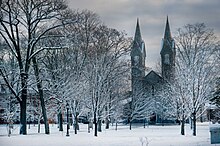
While there is no national standard in the United States, the term "university" primarily designates institutions that provide undergraduate and
Usage of the terms varies among the states. In 1996, for example, Georgia changed all of its four-year institutions previously designated as colleges to universities, and all of its vocational technology schools to technical colleges.
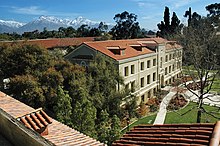
The terms "university" and "college" do not exhaust all possible titles for an American institution of higher education. Other options include "institute" (
The term college is also, as in the United Kingdom, used for a constituent semi-autonomous part of a larger university but generally organized on academic rather than residential lines. For example, at many institutions, the undergraduate portion of the university can be briefly referred to as the college (such as The
Residential colleges
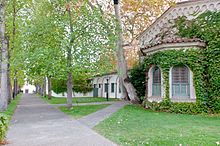
Some American universities, such as Princeton, Rice, and Yale have established residential colleges (sometimes, as at Harvard, the first to establish such a system in the 1930s, known as houses) along the lines of Oxford or Cambridge.[25] Unlike the Oxbridge colleges, but similarly to Durham, these residential colleges are not autonomous legal entities nor are they typically much involved in education itself, being primarily concerned with room, board, and social life.[26] At the University of Michigan, University of California, San Diego and the University of California, Santa Cruz, each residential college teaches its own core writing courses and has its own distinctive set of graduation requirements.
Many U.S. universities have placed increased emphasis on their residential colleges in recent years. This is exemplified by the creation of new colleges at Ivy League schools such as Yale University[27] and Princeton University,[28] and efforts to strengthen the contribution of the residential colleges to student education, including through a 2016 taskforce at Princeton on residential colleges.[29]
Origin of the U.S. usage
The founders of the first institutions of higher education in the United States were graduates of the University of Oxford and the University of Cambridge. The small institutions they founded would not have seemed to them like universities – they were tiny and did not offer the higher degrees in medicine and theology. Furthermore, they were not composed of several small colleges. Instead, the new institutions felt like the Oxford and Cambridge colleges they were used to – small communities, housing and feeding their students, with instruction from residential tutors (as in the United Kingdom, described above). When the first students graduated, these "colleges" assumed the right to confer degrees upon them, usually with authority—for example,
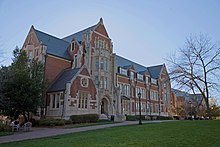
The leaders of Harvard College (which granted America's first degrees in 1642) might have thought of their college as the first of many residential colleges that would grow up into a New Cambridge university. However, over time, few new colleges were founded there, and Harvard grew and added higher faculties. Eventually, it changed its title to university, but the term "college" had stuck and "colleges" have arisen across the United States.
In U.S. usage, the word "college" not only embodies a particular type of school, but has historically been used to refer to the general concept of higher education when it is not necessary to specify a school, as in "going to college" or "college savings accounts" offered by banks.
In a survey of more than 2,000 college students in 33 states and 156 different campuses, the U.S. Public Interest Research Group found the average student spends as much as $1,200 each year on textbooks and supplies alone. By comparison, the group says that's the equivalent of 39 percent of tuition and fees at a community college, and 14 percent of tuition and fees at a four-year public university.[30]
Morrill Land-Grant Act
In addition to private colleges and universities, the U.S. also has a system of government funded,
The act was eventually extended to allow all states that had remained with the Union during the American Civil War, and eventually all states, to establish such institutions. Most of the colleges established under the Morrill Act have since become full universities, and some are among the elite of the world.
Benefits of college
Selection of a four-year college as compared to a two-year junior college, even by marginal students such as those with a C+ grade average in high school and SAT scores in the mid 800s, increases the probability of graduation and confers substantial economic and social benefits.[33][34][35]
Asia
Bangladesh
In Bangladesh, educational institutions offering higher secondary (11th–12th grade) education are known as colleges.[36]
Hong Kong
In Hong Kong, the term 'college' is used by tertiary institutions as either part of their names or to refer to a constituent part of the university, such as the colleges in the collegiate
India
The modern system of education was heavily influenced by the British starting in 1835.[37]
In India, the term "college" is commonly reserved for institutions that offer high school diplomas at year 12 ("Junior College", similar to American high schools), and those that offer the
The first liberal arts and sciences college in India was "Cottayam College" or the "Syrian College", Kerala in 1815. The First inter linguistic residential education institution in Asia was started at this college. At present it is a Theological seminary which is popularly known as Orthodox Theological Seminary or Old Seminary. After that, CMS College, Kottayam, established in 1817, and the
In India a new term has been introduced that is Autonomous Institutes & Colleges. An autonomous Colleges are colleges which need to be affiliated to a certain university. These colleges can conduct their own admission procedure, examination syllabus, fees structure etc. However, at the end of course completion, they cannot issue their own degree or diploma. The final degree or diploma is issued by the affiliated university. Also, some significant changes can pave way under the NEP (New Education Policy 2020) which may affect the present guidelines for universities and colleges.[38]
Israel
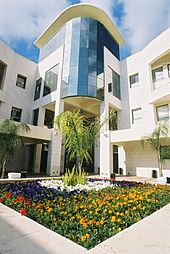
In Israel, any non-university higher-learning facility is called a college. Institutions accredited by the Council for Higher Education in Israel (CHE) to confer a bachelor's degree are called "Academic Colleges" (Hebrew: מִכְלָלָה, romanized: Mikhlala; plural Hebrew: מכללות, romanized: Mikhlalot). These colleges (at least 4 for 2012) may also offer master's degrees and act as Research facilities. There are also over twenty teacher training colleges or seminaries, most of which may award only a Bachelor of Education (BEd) degree.
- Academic colleges: Any educational facility that had been approved to offer at least bachelor's degree is entitled by CHE to use the term academic college in its name.[39]
- Engineering academic college: Any academic facility that offer at least bachelor's degree and most of it faculties are providing an Engineering degree and Engineering license.
- Educational academic college: After an educational facility that had been approved for "Teachers seminar" status is then approved to provide a Bachelor of Education, its name is changed to include "Educational Academic college."
- Technical college: A "Technical college" (מכללה טכנולוגית) is an educational facility that is approved to allow to provide P.E degree (הנדסאי) (14'th class) or technician (טכנאי) (13'th class) diploma and licenses.
- Training College: A "Training College" (מכללה להכשרה or מכללה מקצועית) is an educational facility that provides basic training allowing a person to receive a working permit in a field such as alternative medicine, cooking, Art, Mechanical, Electrical and other professions. A trainee could receive the right to work in certain professions as apprentice (j. mechanic, j. Electrician etc.). After working in the training field for enough time an apprentice could have a license to operate (Mechanic, Electrician[40]). This educational facility is mostly used to provide basic training for low tech jobs and for job seekers without any training that are provided by the nation's Employment Service (שירות התעסוקה).
Macau
Following the Portuguese usage, the term "college" (colégio) in Macau has traditionally been used in the names for private (and non-governmental) pre-university educational institutions, which correspond to form one to form six level tiers. Such schools are usually run by the Roman Catholic church or missionaries in Macau. Examples include Chan Sui Ki Perpetual Help College, Yuet Wah College, and Sacred Heart Canossian College.
Philippines
In the Philippines, colleges usually refer to institutions of learning that grant degrees but whose scholastic fields are not as diverse as that of a university (
A state college may not have the word "college" on its name, but may have several component colleges, or departments. Thus, the Eulogio Amang Rodriguez Institute of Science and Technology is a state college by classification.
Usually, the term "college" is also thought of as a hierarchical demarcation between the term "university", and quite a number of colleges seek to be recognized as universities as a sign of improvement in academic standards (
When it comes to referring to the level of education, college is the term more used to be synonymous to tertiary or higher education. A student who is or has studied his/her undergraduate degree at either an institution with college or university in its name is considered to be going to or have gone to college.
Singapore
The term "college" in Singapore is generally only used for pre-university educational institutions called "Junior Colleges", which provide the final two years of secondary education (equivalent to sixth form in British terms or grades 11–12 in the American system). Since 1 January 2005, the term also refers to the three campuses of the Institute of Technical Education with the introduction of the "collegiate system", in which the three institutions are called ITE College East, ITE College Central, and ITE College West respectively.
The term "university" is used to describe higher-education institutions offering locally conferred degrees. Institutions offering diplomas are called "polytechnics", while other institutions are often referred to as "institutes" and so forth.
Sri Lanka
There are several professional and vocational institutions that offer post-secondary education without granting degrees that are referred to as "colleges". This includes the Sri Lanka Law College, the many Technical Colleges and Teaching Colleges.
Turkey
In Turkey, the term "kolej" (college) refers to a private high school, typically preceded by one year of preparatory language education. Notable Turkish colleges include
Africa
South Africa
Although the term "college" is hardly used in any context at any university in South Africa, some non-university tertiary institutions call themselves colleges. These include teacher training colleges, business colleges and wildlife management colleges. See:
Zimbabwe
The term college is mainly used by private or independent secondary schools with Advanced Level (Upper 6th formers) and also Polytechnic Colleges which confer diplomas only. A student can complete secondary education (International General Certificate of Secondary Education,
Europe
Greece
Kollegio (in Greek Κολλέγιο) refers to the Centers of Post-Lyceum Education (in Greek Κέντρο Μεταλυκειακής Εκπαίδευσης, abbreviated as KEME), which are principally private and belong to the Greek post-secondary education system. Some of them have links to EU or US higher education institutions or accreditation organizations, such as the NEASC.[41] Kollegio (or Kollegia in plural) may also refer to private non-tertiary schools, such as the Athens College.
Ireland

In Ireland the term "college" is normally used to describe an institution of tertiary education. University students often say they attend "college" rather than "university". Until 1989, no university provided teaching or research directly; they were formally offered by a constituent college of the university.
There are number of secondary education institutions that traditionally used the word "college" in their names: these are either older, private schools (such as Belvedere College, Gonzaga College, Castleknock College, and St. Michael's College) or what were formerly a particular kind of secondary school. These secondary schools, formerly known as "technical colleges," were renamed "community colleges," but remain secondary schools.
The country's only
Among more modern foundations, the National University of Ireland, founded in 1908, consisted of constituent colleges and recognised colleges until 1997. The former are now referred to as constituent universities – institutions that are essentially universities in their own right. The National University can trace its existence back to 1850 and the creation of the Queen's University of Ireland and the creation of the Catholic University of Ireland in 1854. From 1880, the degree awarding roles of these two universities was taken over by the Royal University of Ireland, which remained until the creation of the National University in 1908 and Queen's University Belfast.
The state's two new universities, Dublin City University and University of Limerick, were initially National Institute for Higher Education institutions. These institutions offered university level academic degrees and research from the start of their existence and were awarded university status in 1989 in recognition of this.
Third level technical education in the state has been carried out in the
A number of private colleges exist such as Dublin Business School, providing undergraduate and postgraduate courses validated by QQI and in some cases by other universities.
Other types of college include colleges of education, such as the Church of Ireland College of Education. These are specialist institutions, often linked to a university, which provide both undergraduate and postgraduate academic degrees for people who want to train as teachers.
A number of state-funded further education colleges exist – which offer vocational education and training in a range of areas from business studies and information and communications technology to sports injury therapy. These courses are usually one, two or less often three years in duration and are validated by QQI at Levels 5 or 6, or for the BTEC Higher National Diploma award, which is a Level 6/7 qualification, validated by Edexcel. There are numerous private colleges (particularly in Dublin and Limerick)[42] which offer both further and higher education qualifications. These degrees and diplomas are often certified by foreign universities/international awarding bodies and are aligned to the National Framework of Qualifications at Levels 6, 7 and 8.
Netherlands
In the Netherlands there are 3 main educational routes after high school.
- MBO (middle-level applied education), which is the equivalent of junior college. Designed to prepare students for either skilled trades and technical occupations and workers in support roles in professions such as engineering, accountancy, business administration, nursing, medicine, architecture, and criminology or for additional education at another college with more advanced academic material.[43]
- HBO (higher professional education), which is the equivalent of college and has a professional orientation. After HBO (typically 4–6 years), pupils can enroll in a (professional) master's program (1–2 years) or enter the job market. The HBO is taught in vocational universities (hogescholen), of which there are over 40 in the Netherlands, each of which offers a broad variety of programs, with the exception of some that specialize in arts or agriculture. Note that the hogescholen are not allowed to name themselves university in Dutch. This also stretches to English and therefore HBO institutions are known as universities of applied sciences.[44]
- WO (Scientific education), which is the equivalent to university level education and has an academic orientation.[44]
HBO graduates can be awarded two titles, which are Baccalaureus (bc.) and Ingenieur (ing.). At a WO institution, many more bachelor's and master's titles can be awarded. Bachelor's degrees: Bachelor of Arts (BA), Bachelor of Science (BSc) and Bachelor of Laws (LLB). Master's degrees: Master of Arts (MA), Master of Laws (LLM) and Master of Science (MSc). The PhD title is a research degree awarded upon completion and defense of a doctoral thesis.[11]
Portugal
Presently in Portugal, the term colégio (college) is normally used as a generic reference to a private (non-government) school that provides from basic to secondary education. Many of the private schools include the term colégio in their name. Some special public schools – usually of the boarding school type – also include the term in their name, with a notable example being the Colégio Militar (Military College). The term colégio interno (literally "internal college") is used specifically as a generic reference to a boarding school.
Until the 19th century, a colégio was usually a secondary or pre-university school, of public or religious nature, where the students usually lived together. A model for these colleges was the Royal College of Arts and Humanities, founded in Coimbra by King John III of Portugal in 1542.
United Kingdom
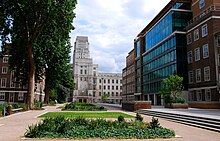
Secondary education and further education
Further education (FE) colleges and sixth form colleges are institutions providing further education to students over 16. Some of these also provide higher education courses (see below).[45] In the context of secondary education, 'college' is used in the names of some private schools, e.g. Eton College and Winchester College.
Higher education
In higher education, a college is normally a provider that does not hold university status, although it can also refer to a constituent part of a
In England, as of August 2016[update], over 60% of the higher education providers directly funded by
Colleges within universities vary immensely in their responsibilities. The large constituent colleges of the University of London are effectively universities in their own right; colleges in some universities, including those of the University of the Arts London and smaller colleges of the University of London, run their own degree courses but do not award degrees; those at the University of Roehampton provide accommodation and pastoral care as well as delivering the teaching on university courses; those at Oxford and Cambridge deliver some teaching on university courses as well as providing accommodation and pastoral care; and those in Durham, Kent, Lancaster and York provide accommodation and pastoral care but do not normally participate in formal teaching. The legal status of these colleges also varies widely, with University of London colleges being independent corporations and recognised bodies, Oxbridge colleges, colleges of the University of the Highlands and Islands (UHI) and some Durham colleges being independent corporations and listed bodies, most Durham colleges being owned by the university but still listed bodies, and those of other collegiate universities not having formal recognition. When applying for undergraduate courses through UCAS, University of London colleges are treated as independent providers, colleges of Oxford, Cambridge, Durham and UHI are treated as locations within the universities that can be selected by specifying a 'campus code' in addition to selecting the university, and colleges of other universities are not recognised.[49][50][51][52][53]
The UHI and the University of Wales Trinity Saint David (UWTSD) both include further education colleges. However, while the UHI colleges integrate FE and HE provision, UWTSD maintains a separation between the university campuses (Lampeter, Carmarthen and Swansea) and the two colleges (Coleg Sir Gâr and Coleg Ceredigion; n.b. coleg is Welsh for college), which although part of the same group are treated as separate institutions rather than colleges within the university.[54][55]
A university college is an independent institution with the power to award taught degrees, but which has not been granted university status. University College is a protected title that can only be used with permission, although note that University College London, University College, Oxford and University College, Durham are colleges within their respective universities and not university colleges (in the case of UCL holding full degree awarding powers that set it above a university college), while University College Birmingham is a university in its own right and also not a university college.
Oceania
Australia
In Australia a college may be an institution of tertiary education that is smaller than a university, run independently or as part of a university. Following a reform in the 1980s many of the formerly independent colleges now belong to a larger universities.
Referring to parts of a university, there are residential colleges which provide residence for students, both undergraduate and postgraduate, called university colleges. These colleges often provide additional tutorial assistance, and some host theological study. Many colleges have strong traditions and rituals, so are a combination of dormitory style accommodation and fraternity or sorority culture.
Most technical and further education institutions (
New Zealand
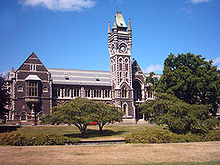
The constituent colleges of the former University of New Zealand (such as Canterbury University College) have become independent universities. Some halls of residence associated with New Zealand universities retain the name of "college", particularly at the University of Otago (which although brought under the umbrella of the University of New Zealand, already possessed university status and degree awarding powers). The institutions formerly known as "Teacher-training colleges" now style themselves "College of education".
Some universities, such as the University of Canterbury, have divided their university into constituent administrative "Colleges" – the College of Arts containing departments that teach Arts, Humanities and Social Sciences, College of Science containing Science departments, and so on. This is largely modelled on the Cambridge model, discussed above.
Like the United Kingdom some professional bodies in New Zealand style themselves as "colleges", for example, the Royal Australasian College of Surgeons, the Royal Australasian College of Physicians.
In some parts of the country, secondary school is often referred to as college and the term is used interchangeably with high school. This sometimes confuses people from other parts of New Zealand. But in all parts of the country many secondary schools have "College" in their name, such as Rangitoto College, New Zealand's largest secondary.
Notes
- ^ Exceptions are made for "mature" student, meaning 21 years of age or over, and out of the educational system for at least 2 years.
References
- ^ "Everything You Need to Know About Community Colleges: FAQ". Archived from the original on 28 October 2021. Retrieved 28 October 2021.
- ^ Oxford English Dictionary, 1891, s.v., definition 4c
- ^ "Nuuk - Arms (crest) of Nuuk". www.heraldry-wiki.com. 30 September 2018. Archived from the original on 7 September 2021. Retrieved 7 January 2022.
- ^ Cassell's Latin Dictionary, Marchant, J.R.V, & Charles, Joseph F., (Eds.), Revised Edition, 1928: lego; colligo
- ^ Cassell's Latin Dictionary, Marchant, J.R.V, & Charles, Joseph F., (Eds.), Revised Edition, 1928, p.107
- ^ Cust, Lionel (7 January 1899). "A history of Eton college". London : Duckworth – via Internet Archive.
- ^ "college noun (EDUCATION)". Cambridge Dictionary Online. Archived from the original on 4 September 2011.
- ^ "Children & families". City of Paris. Archived from the original on 5 September 2012. Retrieved 20 July 2010.
- ^ Private Elementary and Secondary Schools Archived 9 January 2009 at the Wayback Machine search form on the Ministry of Education of Ontario web site—enter "college" in the "name contains" field and check the "secondary" checkbox
- ^ Find a School or School Board Archived 8 September 2009 at the Wayback Machine search form on the Ministry of Education of Ontario web site—click "Secondary" and "Separate"
- ^ a b "What's the difference between HBO and WO?". TU Delft. Archived from the original on 28 July 2020. Retrieved 29 June 2020.
- ^ "College and University in Canada: What Is the Difference?". World Education Services. Archived from the original on 8 October 2021. Retrieved 8 October 2021.
- ^ "College of Biological Science". University of Guelph. Archived from the original on 26 June 2010. Retrieved 19 June 2010.
- ^ Find a School or School Board Archived 2009-09-08 at the Wayback Machine search form on the Ministry of Education of Ontario web site—click "Secondary" and "Separate"
- ^ "Canada Capstone College – Opening hours – 360 Robson Street, Vancouver, British Columbia – Customer Reviews | Canada Online". vancouver.cdncompanies.com. Archived from the original on 11 April 2018. Retrieved 11 April 2018.
- ^ "Why Study at College". college.uc.cl. Pontifical Catholic University of Chile.
- ^ "Education System Chile. Described and compared with the Dutch system" (PDF). Nuffic: The Dutch organisation for internationalisation in education.
- ^ "List of every International School in Santiago". www.international-schools-database.com. Retrieved 7 July 2023.
- ^ NCES. "Fast Facts – Educational Institutions". Retrieved 27 January 2023.
- ^ "College". Merriam-Webster dictionary. Merriam-Webster. Retrieved 27 January 2023.
- ^ "Taxpayer Subsidies for Most Colleges and Universities Average Between $8,000 to More than $100,000 for Each Bachelor's Degree, New Study Finds" (Press release). American Institutes for Research. 12 May 2011. Archived from the original on 30 December 2013.
- ^ "State Education Subsidies Shift Students to Public Universities". www.nber.org. Archived from the original on 24 September 2017.
- ^ Fethke, Gary (1 April 2012). "Why Does Tuition Go Up? Because Taxpayer Support Goes Down". Archived from the original on 20 April 2013 – via The Chronicle of Higher Education.
- ^ Masci, David (1998). Should colleges get back to basics?. CQ Researcher. Congressional Quarterly.
- ^ Robert J. O'Hara. "Samuel Eliot Morison on the Harvard Houses". The Collegiate Way. Archived from the original on 26 October 2016. Retrieved 17 January 2017.
- ^ Robert J. O'Hara (8 October 2002). "Collegiate Developments at Durham and Princeton". The Collegiate Way. Archived from the original on 10 January 2017. Retrieved 17 January 2017.
The University of Durham is the third oldest collegiate university in Great Britain, and most of Durham's residential colleges are creatures of the central university rather than legally independent corporations. In this respect, the Durham colleges are closer in structure to the residential colleges that have been established in the United States and elsewhere in recent years than are the independent corporations of Oxford and Cambridge.
- ^ "The New Residential Colleges". Yale University. Archived from the original on 6 May 2016.
- ^ "Housing & Dining". Princeton University. Archived from the original on 11 May 2016.
- ^ "Task Force on the Residential College Model". Planning for Princeton's Future. Princeton University. Archived from the original on 4 June 2016.
- ^ Bidwell, Allie (28 January 2014). "Report: High Textbook Prices Have College Students Struggling". U.S. News. Archived from the original on 27 February 2015.
- ^ a b c Lightcap, Brad. "The Morrill Act of 1862". ND.edu. Archived from the original on 8 January 2008.
- ^ "A Land-Grant Institution". Dafvm.msstate.edu. 11 August 2009. Archived from the original on 10 June 2010. Retrieved 14 September 2009.
- ^ David Leonhardt (24 April 2015). "College for the Masses" (Upshot blog). The New York Times. Archived from the original on 26 April 2015. Retrieved 26 April 2015.
Only about a third of young adults today receive a bachelor's degree. The new research confirms that many more teenagers have the ability to do so—and would benefit from it
- (PDF) from the original on 6 May 2015.
- ^ Seth Zimmerman (May 2013). "The Returns to College Admission for Academically Marginal Students" (PDF). Archived from the original (PDF) on 31 March 2015. Retrieved 26 April 2015.
Students with grades just above a threshold for admissions eligibility at a large public university in Florida are much more likely to attend any university than below-threshold students. The marginal admission yields earnings gains of 22 percent between eight and fourteen years after high school completion. These gains outstrip the costs of college attendance, and are largest for male students and free lunch recipients.
- ^ "HSC registration begins June 29, no eligibility tests in colleges". The Financial Express. Archived from the original on 17 July 2021. Retrieved 17 July 2021.
- ^ "Influence of modern education on the culture of India". 14 March 2010. Archived from the original on 30 July 2017.
- ^ "Autonomous, Deemed, Private, State & Central Universities: Know the Difference | Shiksha". www.shiksha.com. Archived from the original on 16 May 2017. Retrieved 2 December 2020.
- ^ "חוק המועצה להשכלה גבוהה" (מל"ג), תשי"ח-1958, רק מוסד להשכלה גבוהה שקיבל את אישור המועצה להשכלה גבוהה יהיה רשאי להשתמש בכינוי "מכללה אקדמית".
- ^ תקנות החשמל (רשיונות), התשמ"ה-1985 Archived 9 May 2012 at the Wayback Machine
- ^ "Search". Colleges & Universities (CIHE) / Commission on Institutions of Higher Education. Archived from the original on 20 March 2018. Retrieved 6 December 2016.
- ^ "Private Colleges Dublin". Education in Ireland. Archived from the original on 20 July 2021. Retrieved 20 July 2021.
- ^ Ministerie van Onderwijs, Cultuur en Wetenschap (16 December 2011). "Secondary vocational education (MBO) - Secondary vocational education (MBO) and higher education - Government.nl". www.government.nl. Archived from the original on 29 June 2020. Retrieved 29 June 2020.
- ^ a b "Tertiary (higher) education". Secondary vocational education (MBO) and tertiary (higher) education. Government.nl. 16 December 2011. Archived from the original on 7 August 2023.
- ^ "Further education – Colleges and other institutions". Education UK. British Council. Archived from the original on 19 January 2017. Retrieved 28 August 2016.
- ^ Keiran Southern (29 June 2016). "Newcastle education group to become first in the country to award its own degree courses". ChronicleLive. Archived from the original on 18 September 2016.
- HEFCE. Archivedfrom the original on 3 September 2016. Retrieved 28 August 2016.
- HEFCE. Archivedfrom the original on 11 September 2016. Retrieved 28 August 2016.
- ^ "Search courses". UCAS. Archived from the original on 26 August 2016. Retrieved 28 August 2016.
- ^ R. J. O'Hara (20 December 2004). "The Collegiate System at the University of Durham". The Collegiate Way. Archived from the original on 6 October 2006. Retrieved 28 August 2016.
- ^ "The Education (Listed Bodies) (England) Order 2013". Legislation.gov.uk. 27 November 2013. Archived from the original on 31 July 2015.
- ^ "The Education (Recognised Bodies) (England) Order 2013". Legislation.gov.uk. 27 November 2013. Archived from the original on 31 August 2016.
- ^ "List of institution and campus codes". UCAS. Archived from the original (XLS) on 19 September 2016. Retrieved 28 August 2016.
- ^ "About UHI". University of the Highlands and Islands. Archived from the original on 20 September 2016. Retrieved 28 August 2016.
- ^ "UWTSD Group". University of Wales Trinity Saint David. Archived from the original on 19 September 2016. Retrieved 28 August 2016.
